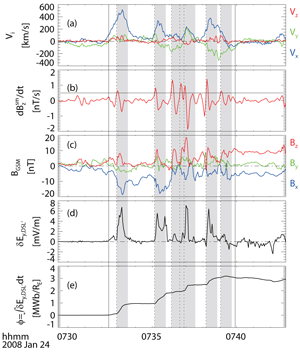
2014 THEMIS SCIENCE NUGGETS
Magnetic flux transport by dipolarizing flux bundles
by Jiang Liu, UCLA EPSS & IGPP
Introduction
A dipolarizing flux bundle (DFB) is a small magnetotail flux tube with a significantly stronger magnetic field than its background. The leading edge of a DFB shows a sharp enhancement of the north-south component of the magnetic field, which is usually referred to as a "dipolarization front" (DF). A DFB typically propagates Earthward at a high speed from the near-Earth reconnection region. During this propagation the DFB is embedded in a ~10 min time scale enhanced plasma flow called "bursty bulk flow" (BBF). Since a DFB contains strong magnetic field and travels fast, it is expected to contribute significantly to the flux transport from the near-Earth reconnection site towards Earth. Its role in this transport, however, has not yet been established.
| Figure 1. A bursty bulk flow event observed by THEMIS P3. From top to bottom are (a) ion bulk velocity, (b) time derivative of three-point (9s) running-averaged Bz, (c) magnetic field, (d) Ey with quiet time average subtracted, and (e) cumulative magnetic flux transport calculated by integrating Ey. The two solid vertical lines indicate the start and end of the BBF. The dashed vertical lines mark DFBs identified inside the BBF. The DFB criterion dBz/dt>0.5 nT/s is illustrated by the solid horizontal line in panel (b). The shaded regions are DFB intervals. |
Results
Since the importance of bursty bulk flows in flux transport has already been established, we seek to determine the importance of DFBs by showing that those embedded in BBFs are the predominant flux carriers of BBFs. Within the ~8-min long BBF of Figure 1, we identified seven DFBs with the BBF following the aforementioned criterion of dBz/dt>0.5 nT/s (Figure 1b). Although this DFB criterion is solely based on the magnetic field, DFB intervals (shaded area) not only have strong magnetic field (Figure 1c) but also coexist with flow bursts (Figure 1a). As a result, DFBs are correlated with strong electric field impulses (Ey, Figure 1d). The electric field Ey represents the transport rate of magnetic flux towards Earth; its time integration gives cumulative flux transport. The DFBs’ strong electric field allows them to contribute >90% of the BBF’s cumulative flux transport (Figure 1e), although they occupy only ~50% of the BBF duration.
We extend what we have done in Figure 1 to ~1200 BBFs identified during THEMIS’ four tail seasons. On average, DFBs occupy only ~30% of the BBF duration but are responsible for ~70% of the BBFs’ flux transport. Thus, DFBs are the effective flux transporter of the BBFs. Since BBFs have been found to appear 10-15% of the time in the near-Earth region but contribute 60-100% of the flux transport there, DFBs appear 3-5% of the time but transport 40-70% of the near-Earth magnetic flux. Dipolarizing flux bundles are the major and highly efficient flux transporter of the near-Earth magnetotail.
Recognizing the important role of DFBs in near-Earth flux transport, we further investigated their transport properties with a statistical database of ~1900 DFBs. We found that the rate of DFB flux transport increases with proximity to Earth and to the premidnight sector, as well as with geomagnetic activity and distance from the neutral sheet. Under the latter two conditions, the total flux transport by a typical DFB also increases. Dipolarizing flux bundles appear more often during increased geomagnetic activity (see Liu et al. [2014] for details about these results).
Conclusion
In addition to carrying ~70%of the BBF flux transport, DFBs excite ambient flows preceding and trailing them, which are responsible for most of the remainder of the BBF flux transport. The flow bursts of the DFBs themselves are also produced by the DFBs’ strong magnetic curvature force. Therefore, DFBs drive nearly all the BBF flux transport--they not only carry but also drive most of the flux transport in the near-Earth magnetotail. These DFB flux transport properties inform us about processes that shape global convection and energy conversion.
Reference
Liu, J., V. Angelopoulos, X.-Z. Zhou, and A. Runov (2014), Magnetic flux transport by dipolarizing flux bundles, J. Geophys. Res. Space Physics, 119, 909–926, doi:10.1002/2013JA019395.Biographical Note
Jiang Liu is an assistant researcher within UCLA's Department of Earth, Planetary, and Space Sciences. His research interests include substorms and transient energy carriers in the magnetosphere.
 Please send comments/suggestions to
Emmanuel Masongsong / emasongsong @ igpp.ucla.edu
Please send comments/suggestions to
Emmanuel Masongsong / emasongsong @ igpp.ucla.edu

